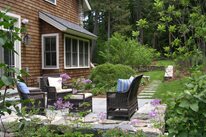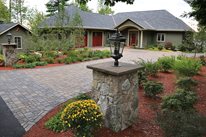How to Transform a Side Yard with Stock Tanks
See how galvanized troughs planted with hydrangeas serve as a barrier between neighboring homes
-
Four hydrangea-filled stock tanks were used to create an attractive barrier along the side of these two homes.
-
 Here is a view of the side yard before the transformation.
Here is a view of the side yard before the transformation.
-
This process photo shows the new walkway, median strip and empty stock tanks.
-
This image shows the side yard the first season after planting.
- 1
- 2
- 3
- 4
Side yards are often one of the most neglected areas of a landscape, becoming a no man’s land populated only by garbage cans, air conditioning units and the occasional meter reader. When the owners of this Cambridge, Mass. property decided they were tired of the unused strip next to their home they hired Andrea Nilsen of Nilsen Landscape Design to help them reinvigorate the wasted space.
Measuring just 5-feet wide by 48-feet long, and under shadows from the neighboring home most of the day, the space was quite a challenge. Overall the goal was to create an attractive walkway that would lead to the backyard. “The homeowner has a whimsical sense of humor and bought some troughs without any real idea of where or how to use them and asked me to incorporate them into the landscape, so I decided to use them as a barrier, between his side yard and his neighbor's side yard,” recalls Nilsen. Here is how she did it:
Step 1: Property Survey & DemolitionFirst, she had the property surveyed and discovered they actually had 6-feet additional space to work with. So the existing chain-link fence and gate were replaced with wrought-iron perpendicular to the back corner of the house that recaptured the extra space. “This gate also serves as a destination at the end of the new bluestone walkway,” she says. Second, Nilsen had a big tree and shrub removed opening up access to the side yard. The existing hardscape materials were also removed.
Step 2: Hardscape InstallationNow with the space cleared, Andrea was ready to implement her design. A new walkway was laid with bluestone steppers in a bed of pea gravel, while granite cobblestone edging was used to frame out a median strip that straddles the property line and serves as a home for the stock tanks. “Luckily we had cooperation from the neighbor and even ended up redoing their walkway to match so that the whole space is cohesive,” she explains.
Step 3: Stock Tank Placement & PlantingNext came the placement and planting of the stock tanks. “We drilled drainage holes in each trough, connected them to drip irrigation, and filled them with stone and soil for good drainage,” states Nilsen. The tanks were planted with Hydrangea quercifolia 'Alice', which according to Nilsen do well in the shady area, get quite big, and have gorgeous texture and color in three seasons. “The troughs are galvanized to prevent rust and we keep irrigation on the plants and a layer of mulch keeps the soil cool. We haven't had any issues with rust or overheating.”
Step 4: Planting the Median Strip“In order to anchor the planters, I also planted the median strip with plants that knit together in a nice tapestry of color,” she adds. The plants used were:
- Hosta ‘Northern Exposure’
- Nepeta racemosa ‘Little Titch’
- Hakonochloa ‘Aureola’
- Ajuga reptans
- Alchemilla mollis
- Sedum ‘Vera Jamesson’
Now instead of the familiar no man’s land, this side yard provides a wonderful transition from the front of the home to the backyard, which was also transformed into an outdoor entertaining space. Nilsen and the homeowner couldn’t be happier with the stock tank solution they implemented and how it has matured since its installation.
Nilsen Landscape Design, LLC
Boston, MA
|
Contributing Author: Sarah Hutchinson, contributing writer for Landscaping Network |



 Side Yard Landscaping
Side Yard Landscaping Boston Landscaping
Boston Landscaping Featured Projects
Featured Projects

